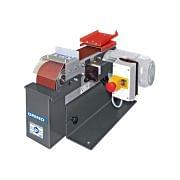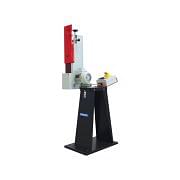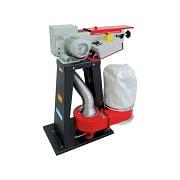Belt sanders
At the heart of machine shops, belt sanders are an indispensable tool for finishing and machining metal and non-metal materials.
Belt sanders are machine tools mainly used for sanding, grinding and finishing surfaces of different materials. Their operation is based on an abrasive belt that, moving at high speed, removes excess material from the surface of the workpiece. This process is essential to achieve precise finishes and smooth surfaces, which are essential in many mechanical applications.
Belt sanders are available in various models and sizes, each designed to meet specific needs. Professional belt sanders are characterised by their robust construction, powerful motors and high-quality abrasive belts. These tools are ideal for intensive use in workshops where precision and durability are required.
One of the main features of belt sanders is their versatility. They can be used to work on a wide range of materials, including metals, wood, plastics and composites. This flexibility makes them an essential tool in a variety of work contexts, from machine shops to carpentry workshops.
Knowing how to use a belt sander is crucial to achieving the best results. Before starting, it is important to choose the right sanding belt according to the material to be processed and the type of finish desired. Correct setting of the machine, including belt tension and feed speed, is crucial to ensure efficient and safe operation.
During use, it is essential to maintain a constant and uniform movement of the workpiece. This helps prevent unwanted marks and achieve a smooth finish. Safety is another crucial aspect: always wear personal protective equipment, such as goggles and gloves, to protect against debris and abrasive particles.
The best belt sanders for workshops offer several advantages. Firstly, they enable extremely smooth and precise surfaces, improving the overall quality of the finished products. They also reduce the time needed for sanding compared to manual methods, increasing operational efficiency.
Metal belt sanders are particularly appreciated for their ability to quickly remove material and prepare surfaces for subsequent treatments, such as painting or welding. This efficiency translates into a significant reduction in processing time and associated costs.
To ensure a long working life and optimum performance, regular maintenance of belt sanders is essential. Cleaning the sanding belts and replacing them when necessary, lubricating the moving parts and periodically checking the belt alignment are key operations to keep the machine in perfect condition.
Frequently Asked Questions
What is the difference between a belt sander and an orbital sander?
Belt sanders use a continuous abrasive belt that moves in a constant cycle, ideal for quickly removing large amounts of material. Orbital sanders, on the other hand, use an oscillating motion for a finer, more detailed finish.
Can I use a belt sander on curved surfaces?
Yes, some belt sanders are designed with specific accessories for working on curved surfaces. However, it is important to use the machine carefully to avoid damaging the workpiece.
In conclusion, belt sanders are essential tools in machine shops. They offer versatility, efficiency and precision, making them a valuable investment for any task requiring a high quality finish. With proper maintenance and use, these machines can significantly improve productivity and work quality.




